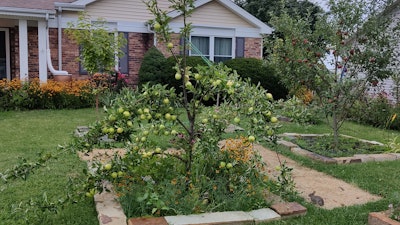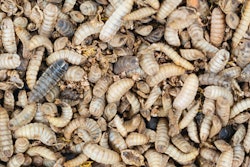
Keep off the lawn and just say no to grass. Pet food companies can practice regenerative agriculture on their own corporate campuses and in employees' yards by replacing European turfgrass with mixtures of edible plants, native grasses and wildflowers, and non-invasive ornamentals. Restoring ecosystems while producing food can form part of pet food companies' sustainability initiatives.
“I think lawns are dumb,” Mark Kleinschmit, PhD, co-founder and COO/CFO at Other Half Processing, a regenerative leather goods provider, said in response to my question about the potential for regenerative company gardens during a panel discussion sponsored by the Pet Sustainability Coalition during the Pet Summit on March 25 in Orlando, Florida. “It’s something we got from the British… It was a fashion.”
Lawns accompanied English colonizers into North America, but large expanses of trimmed grass remained a luxury until lawnmowers and nitrogen fertilizer became readily available. The rise of suburban lawns coincided with the decline of the family farm.
Growth of lawns in the United States
In 1920, the U.S. census recorded more people in urban areas than rural for the first time. At the same time, industrial developments made lawns more feasible in cities and suburbs. Maintaining a lawn used to require either sheep or intensive manual labor with scythes. Mechanical lawnmowers were invented in 1830, but it wasn’t until 1938 that the first gas-powered mowers appeared on the U.S. market. Along with the rise of the lawnmowers, chemists made nitrogen fertilizer readily available by developing a means to pull nitrogen from the air. With abundant fertilizer to make grass grow and lawnmowers to cut that growth down, lawns were primed to become a cultural fixture of U.S. homes and businesses. Those lawns could be considered the country’s top crop, according to scientists who analyzed maps of the U.S. to determine the extent of lawns.
“The analysis indicates that turf grasses, occupying about 2% of the surface of the continental U.S., would be the single largest irrigated crop in the country,” researchers with the National Aeronautics and Space Administration, National Oceanic and Atmospheric Administration and academic institutions wrote in a report published by the International Society for Photogrammetry and Remote Sensing.
While the researchers concluded that lawns sequestered carbon, or removed the element from the atmosphere and stored it in the soil, they also noted that lawn maintenance mitigates the environmental benefits of that carbon capture. Lawnmowers, for example, tend to be fuel-inefficient and produce air pollution. The Haber Bosch process provides abundant ammonia for making fertilizer (and explosives). However, this industrial-scale ammonia production also consumes 3-5% of annual natural gas production and contributes to climate change. What’s more, people tend to overfertilize their lawns to achieve a vibrant green. When that excess fertilizer is washed into streams, rivers and the ocean, it can trigger algae blooms and lead to oxygen-starved, anoxic aquatic dead zones. Similarly, pesticides and herbicides applied to lawns can end up in the water. The irrigation water that contributed to that run-off can be problematic, too. People often use drinking water for irrigating their lawns. For example, most people hook up the hose to their home or business’s tap water to give the lawn a drink, as opposed to using a greywater system or rain collection. By using tap water, lawn irrigation can drain groundwater supplies, increase loads on water treatment centers and compete with human hydration needs. For these reasons, the carbon-sequestration potential of lawn grass is outweighed by pollution and resource use.
Restoring native ecosystems or using regenerative agriculture resolves many of these problems with lawns. Regenerative agriculture uses techniques that actively improve soil health, biodiversity, water cycling and other ecosystem processes while still providing food. Regenerative agriculture can boost soil fertility and drought resistance. Biodiversity increases too, improving ecosystem resilience. A wide range of farming and ranching practices fall under the regenerative agriculture heading. Planting leguminous cover crops, for example, allows farmers to reduce erosion, retain soil moisture and add nitrogen to the soil naturally.
Regenerative agricultural principles can be applied to replacing lawns on pet food company’s properties or on employees' homes. The techniques can even be adapted to make existing turf grass more environmentally responsible. Creating and maintaining a regenerative garden takes more effort and engagement than paying a lawn service to mow once a week. However, a company garden can foster teamwork and build connections among employees as pet food professionals work together to grow their own fruits, vegetables and flowers.
At home, gardens can make a house stand out while providing a reliable source of ethically produced, local foods. Before getting started, potential gardeners may need to check with their homeowners association to make sure their regenerative garden stays within neighborhood rules, Eric Allphin, vice president of business development at Renew Biomass said during the Pet Summit.
Plan for converting lawns to regenerative agriculture
Pet food professionals don’t need to go back to school for an agronomy degree to embrace regenerative agriculture. I used ChatGPT to create this plan for turning a lawn into a sustainable garden in the Midwest. Along with AI, the internet provides many sources of knowledge and advice for saying “be gone” to a lawn.
Phase 1: Planning and Preparation (Late Winter to Early Spring)
1. Site Assessment
- Soil Testing: Collect soil samples and send to a lab (e.g., your local university extension) to assess pH, organic matter, and nutrients.
- Sunlight Mapping: Track how sunlight hits the yard throughout the day.
- Water Flow: Observe drainage patterns to manage runoff and erosion.
- Existing Vegetation: Identify what’s growing and note any invasive species.
2. Design the Layout
- Zones: Allocate areas for:
- Annual vegetable beds
- Perennial plants and shrubs
- Pollinator habitats
- Compost system
- Rainwater harvesting or swales
- Access Paths: Plan paths to reduce soil compaction and improve accessibility.
- No-Till Approach: Opt for sheet mulching instead of sod removal.
Phase 2: Lawn Removal & Soil Building (Early to Mid-Spring)
1. Sheet Mulching (Lasagna Method)
- Mow grass short and leave clippings in place.
- Layer cardboard or newspaper to smother grass.
- Add compost, aged manure, and mulch (e.g., straw, wood chips).
- Water each layer as you build.
2. Composting Setup
- Build bins or use tumblers to process food scraps, leaves, and garden waste.
- Include a worm bin (vermicomposting) for high-quality castings.
3. Inoculation with Soil Microbes
- Apply compost teas or microbial inoculants to boost soil life.
Phase 3: Planting and Establishment (Late Spring to Early Summer)
1. Choose Regenerative Crops
- Nitrogen Fixers: Beans, peas, clover
- Pollinator Support: Echinacea, bee balm, milkweed
2. Install Garden Beds
- Broad beds or raised mounds using compost and mulch
- No tilling—plant directly into mulch or add compost layer before seeding
3. Companion Planting
- Interplant to deter pests and enhance soil health (e.g., tomatoes with basil, corn with beans and squash)
Phase 4: Water and Weed Management (Summer)
1. Watering
- Use drip irrigation or soaker hoses to minimize evaporation
- Mulch heavily to retain soil moisture
2. Weeding
- Hand-pull or use a hoe; do not disturb soil structure
- Let some weeds grow if they support pollinators or accumulate minerals
Phase 5: Fall Transition and Perennial Establishment
1. Add Perennials
- Fruit trees (apple, pear)
- Berry bushes (raspberry, currant)
- Herbs (oregano, thyme, sage)
2. Cover Crops
- Plant clover, rye, or vetch to fix nitrogen and protect soil over winter
3. Leaf Mulching
- Use fallen leaves as mulch and compost material
Ongoing Maintenance & Regenerative Practices
1. Soil Health Monitoring
- Test soil every 2–3 years
- Look for increases in organic matter and earthworm activity
2. Keep It Covered
- Maintain living roots or mulch year-round
3. Minimal Disturbance
- No tilling or turning soil; let microbes and roots do the work
4. Rotate and Diversify
- Avoid planting the same crops in the same beds every season


















